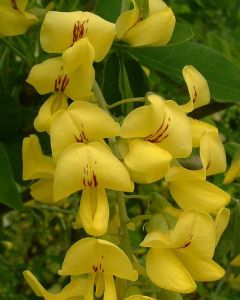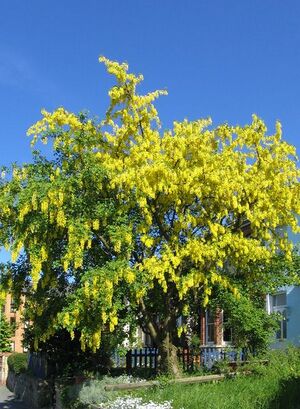Laburnum
| Standard Cyclopedia of Horticulture |
|---|
|
Laburnum (ancient Latin name). Leguminosae. Including Podocytisus. Golden-chain. Ornamental trees or shrubs chiefly grown for their showy racemes of yellow flowers. Deciduous: lvs. alternate, petioled, 3-foliolate, without stipules: fls. slender-pedicelled, in terminal simple racemes, mostly pendulous; calyx 2- lipped, with obtuse, short lips; corolla papilionaceous, with the petals all distinct; stamens 10, all connate; ovary stalked: fr. a linear pod with several seeds, compressed, tardily dehiscent; seed without appendage at base.—Three species in S. Eu. and W. Asia, often included under Cytisus. All parts of the plants are poisonous, especially the young frs. The hard, tough and closegrained wood is susceptible of a very fine polish, and is manufactured into various small articles. The golden-chains are handsome small trees with dark green trifoliolate leaves falling late in autumn without change of color, and with drooping racemes of bright yellow flowers in late spring, followed by long narrow pods remaining on the tree a long time. They are adapted for planting on rocky slopes or in borders of shrubberies, where they should be allowed enough space to show to the best advantage their graceful, drooping racemes of golden flowers, which contrast with the dark green foliage. They are hardly ever attacked by insects or fungi.—Laburnum alpinum is the hardiest species and perfectly hardy as far north as Massachusetts; L. anagyroides is somewhat less hardy, while L. caramanicum is tender. They thrive in any kind of well- drained soil, including limestone, and grow as well in partly shaded positions as in sunny ones. Propagated by seeds, sown usually in spring, and also by layers; the varieties are mostly grafted or budded on seedlings of one of the species.
|
| Laburnum {{{status}}} Fossil range: {{{fossil_range}}}
| ||||||||||||||||||||||||||||||||||||||||||||||||||||||||||||||||||
|---|---|---|---|---|---|---|---|---|---|---|---|---|---|---|---|---|---|---|---|---|---|---|---|---|---|---|---|---|---|---|---|---|---|---|---|---|---|---|---|---|---|---|---|---|---|---|---|---|---|---|---|---|---|---|---|---|---|---|---|---|---|---|---|---|---|---|
 Common Laburnum - flowers | ||||||||||||||||||||||||||||||||||||||||||||||||||||||||||||||||||
| Plant Info | ||||||||||||||||||||||||||||||||||||||||||||||||||||||||||||||||||
| ||||||||||||||||||||||||||||||||||||||||||||||||||||||||||||||||||
| Scientific classification | ||||||||||||||||||||||||||||||||||||||||||||||||||||||||||||||||||
| ||||||||||||||||||||||||||||||||||||||||||||||||||||||||||||||||||
| [[{{{diversity_link}}}|Diversity]] | ||||||||||||||||||||||||||||||||||||||||||||||||||||||||||||||||||
| {{{diversity}}} | ||||||||||||||||||||||||||||||||||||||||||||||||||||||||||||||||||
| Binomial name | ||||||||||||||||||||||||||||||||||||||||||||||||||||||||||||||||||
| {{{binomial}}} | ||||||||||||||||||||||||||||||||||||||||||||||||||||||||||||||||||
| Trinomial name | ||||||||||||||||||||||||||||||||||||||||||||||||||||||||||||||||||
| {{{trinomial}}} | ||||||||||||||||||||||||||||||||||||||||||||||||||||||||||||||||||
| Type Species | ||||||||||||||||||||||||||||||||||||||||||||||||||||||||||||||||||
| {{{type_species}}} | ||||||||||||||||||||||||||||||||||||||||||||||||||||||||||||||||||
| Species | ||||||||||||||||||||||||||||||||||||||||||||||||||||||||||||||||||
| Laburnum anagyroides Laburnum alpinum | ||||||||||||||||||||||||||||||||||||||||||||||||||||||||||||||||||
| [[Image:{{{range_map}}}|{{{range_map_width}}}|]] | ||||||||||||||||||||||||||||||||||||||||||||||||||||||||||||||||||
| Synonyms | ||||||||||||||||||||||||||||||||||||||||||||||||||||||||||||||||||
| {{{synonyms}}} |
Laburnum is a genus of two species of small trees in the subfamily Faboideae of the pea family Fabaceae, Laburnum anagyroides (Common Laburnum) and L. alpinum (Alpine Laburnum). They are native to the mountains of southern Europe from France to the Balkan Peninsula. Some botanists include a third species, Laburnum caramanicum, but this native of southeast Europe and Asia Minor is usually treated in a distinct genus Podocytisus, more closely allied to the brooms.

They have yellow pea-flowers in pendulous racemes 10-30 cm (4-12 in) long in spring, which makes them very popular garden trees. In L. anagyroides the racemes are 10-20 cm (4-8 in) long, with densely packed flowers; in L. alpinum the racemes are 20-30 cm (8-12 in) long, but with the flowers sparsely along the raceme.
The leaves are trifoliate, somewhat like a clover, the leaflets typically 2-3 cm (¾-1¼ in) long in L. anagyroides and 4-5 cm (1½-2 in) long in L. alpinum.
Most garden specimens are of the hybrid between the two species, Laburnum x watereri (Voss's Laburnum), which combines the longer racemes of L. alpinum with the denser flowers of L. anagyroides; it also has the benefit of low seed production (Laburnum seed toxicity is a common cause of poisoning in young children, who mistake the seeds for peas).
The yellow flowers are responsible for the old poetic name 'golden chain tree' (also spelled golden chaintree or goldenchain tree).
All parts of the plant are poisonous and can be lethal if consumed in excess. Symptoms of Laburnum poisoning may include intense sleepiness, vomiting, convulsive movements, coma, slight frothing at the mouth and unequally dilated pupils. In some cases, diarrhea is very severe and at times the convulsions are markedly tetanic.
Despite the plant's toxicity, it is used as a food plant by the larvae of some Lepidoptera species including Buff-tip.
References and external links
- Flora Europaea: Laburnum
- ILDIS Legume Database
- time lapse video of a year in the life of a laburnum tree.
- Grieve, 'A Modern Herbal' (1931)